Kite Surfing in Charleston: Your Ultimate Guide
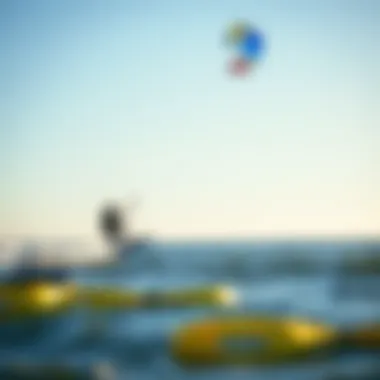
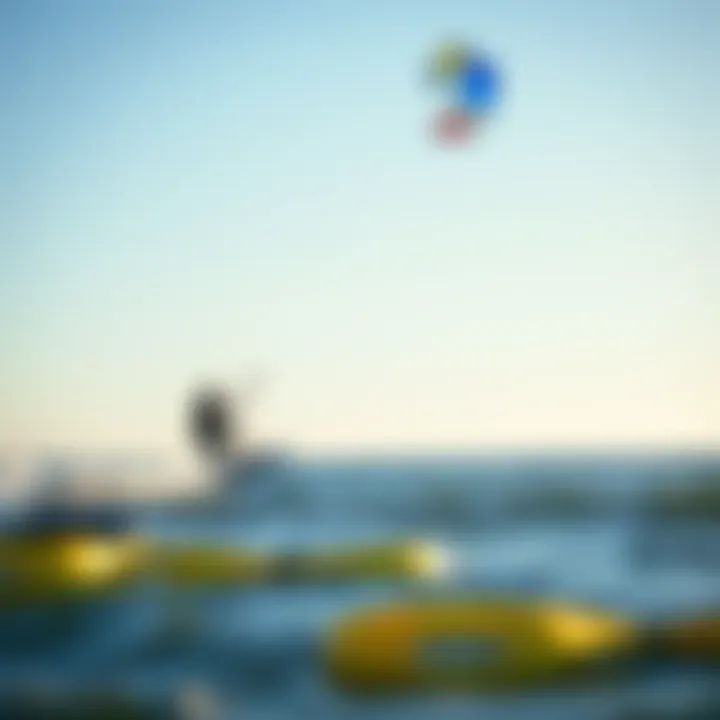
Intro
Kite surfing in Charleston offers an enticing mix of thrill and artistry, making it a sought-after sport among both locals and visitors. This coastal city, known for its vibrant culture and historic charm, provides the perfect backdrop for enthusiasts looking to harness the wind and waves. As with any adventure that captures the imagination, understanding the nuances of kite surfing is key. In this guide, readers will find a deep dive into the essential elements of this sport, including the best locations to ride, the gear you need, and community insights that can elevate your experience.
Whether you're planning to ride the winds for the first time or have been cutting through the waves for years, there's something in this guide for everyone. From understanding the local weather patterns to perfecting your techniques and maintaining your equipment, we've got you covered. Let's start the journey towards mastering the art of kite surfing in Charleston.
Equipment Insights
Understanding what gear to use can make or break your kite surfing experience. While the essence of kite surfing involves using a kite and a board, the nuances of equipment can lead you to a true breakthrough in your performance.
Latest Gear Reviews
- Kite Hydra 9M: This kite is ideal for both beginners and intermediate surfers. Its stability and user-friendly design greatly enhance learning curves while providing a solid performance for seasoned riders.
- Rider Xtreme Board 134: A trusted name among the kite surfing community, this board boasts durability and responsiveness, perfect for tackling both waves and flat waters.
- Safety Harness Pro 2.0: Comfort is key when you’re out on the water for extended periods. This harness ensures that you remain secure without sacrificing mobility.
Essential Gear Maintenance
Keeping your equipment in top-notch condition is crucial for safety and performance. Here are a few tips:
- Kite Cleaning: After a session, rinse your kite with fresh water to remove sand and salt. This will prolong its life.
- Line Checks: Regularly inspect your lines for frays or weaknesses. Swap them out if they show signs of wear.
- Board Care: Store your board away from direct sunlight to prevent damage to its surface. Check for dings and repair promptly.
Technique Exploration
The beauty of kite surfing lies in its blend of thrill and skill. Developing a smooth riding style and mastering various techniques can unlock an array of possibilities on the water.
Beginner Techniques
Starting anew can be daunting, but with practice, the basics will soon become second nature:
- Understanding Wind Directions: Knowing which way the wind blows is important. Spend some time observing before heading out.
- Launching and Landing: Practice these crucial skills on land before attempting in water. A good launch prepares you for a smoother ride.
- Riding Upwind: Learning to angle your board properly can help you maintain direction and control.
Advanced Maneuvers
For those looking to take their kite surfing skills to the next level, consider trying:
- Jumping: Timing your kite movements with your board pop is key. Master this for an exhilarating ride!
- Waveriding: Merging kite surfing with surfing can lead to an exhilarating experience. Know how to read the waves.
- Freestyle Tricks: Move from basic riding to trying spins and flips for added flair, which also impresses fellow riders.
For a great source of additional information, consider visiting Wikihow on Kite Surfing.
Charleston's kite surfing scene is buzzing with energy. The combination of the right kit, keen techniques, and strong community ties makes learning and mastering kite surfing here an exceedingly rewarding journey. Keep pushing your limits and embrace the exhilaration that only this sport can bring.
Prolusion to Kite Surfing
Kite surfing, an exhilarating blend of both wind and water sports, draws enthusiasts from all walks of life. This section sets the stage for understanding the sport's foundations and its place within the vibrant locale of Charleston. It isn’t just about the adrenaline rush; kite surfing offers a unique communion with nature, fostering a connection between the rider and the elements.
Definition and Evolution of the Sport
To start, what exactly is kite surfing? Essentially, it combines elements of surfing, windsurfing, and paragliding. Participants use a large, controllable sail or kite to harness the wind, propelling themselves across the water on a board. Though its roots can be traced back to the late 1970s, when pioneers tinkered with inflatable kites and surfboards, the sport has evolved significantly. Innovations in materials and design have led to more efficient kites and boards that enhance the riding experience. What once was a niche hobby has blossomed into a global phenomenon with an avid following.
Significance of Charleston as a Kite Surfing Destination
Charleston stands out as a prime location for kite surfing, offering an ideal cocktail of consistent wind patterns, diverse water conditions, and breathtaking scenery. The city's coastal geography, characterized by broad beaches and expansive tidal flats, provides kiteboarders of all skill levels with ample opportunities to ride the waves.
Charleston's strong community also plays a vital role, with various events and meet-ups that not only hone skills but also foster camaraderie among kite surfing fanatics. The blend of sporting culture and local charm makes it hard to resist taking the plunge into this sport. As more enthusiasts discover this delightful city as a kite surfing hub, the legend of Charleston continues to grow.
Local Conditions for Kite Surfing
Understanding the local conditions for kite surfing is crucial for any rider wanting to make the most of their experience in Charleston. It encompasses various elements, each affecting the overall enjoyment and safety of the sport. For kite surfers, the wind, water, and seasonal variations play pivotal roles. Familiarity with these factors not only enhances skill but also informs decisions about when and where to kite surf, effectively transforming an average outing into an exceptional ride.
Wind Patterns in Charleston
The wind is the lifeblood of kite surfing. In Charleston, kite surfers often benefit from consistent wind patterns thanks to its coastal environment. Generally, winds from the east and southeast dominate, especially during the spring and summer months. This geographic advantage creates reliable conditions for both novice and experienced kiteboarders.
- In spring, winds typically blow between 12-20 mph. This moderate wind allows new surfers to gain confidence without the risk of overpowering gusts.
- Summer months can see stronger gusts as the wind speeds can climb to 25 mph and beyond, providing thrilling conditions for seasoned riders.
- It’s also important to monitor local forecasts. The winds can change whimsicaly, often influenced by coastal storms or seasonal fronts. Keeping an eye on online resources like Weather.com or local kiteboarding forecasts can help one pick the best days.
"Good winds can turn even a mediocre day on the water into a memorable session."
Water Conditions and Safety
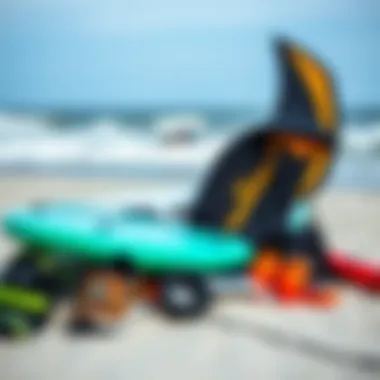
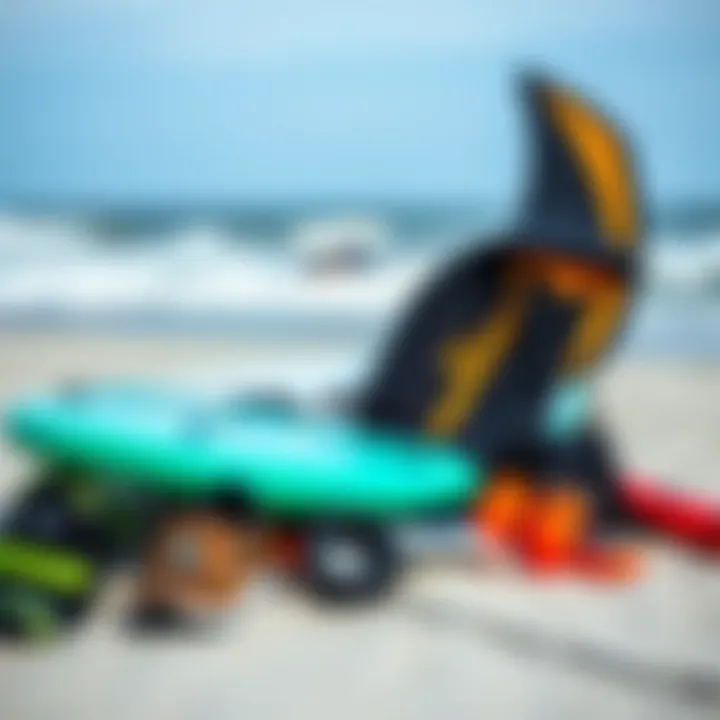
Water conditions in Charleston vary greatly with tides and storms, making it vital for surfers to understand how these factors interplay. The waters here range from calm bay areas to a bit choppy in open seas, which can affect the ease and safety of riding.
- Locations like Folly Beach have larger waves, which can be entertaining yet challenging if you’re not prepared.
- On the other hand, spots with flat water offer a great haven for beginners to practice jumps or tricks without much fear of wipeouts.
Safety cannot be overstated. Always be cautious of:
- Other water users: Jet skis, boats, and swimmers can create hazardous conditions.
- Changing tides: Low water might reveal submerged obstacles, while high tides can pull you out to sea unexpectedly.
- Rip currents: A common concern, understanding rip currents can save a life.
Seasonal Trends and Best Times to Surf
The seasonal calendar in Charleston light up various opportunities for kite surfing, making certain months more favorable than others. Spring and summer traditionally herald peak kite surfing conditions, but riders can find decent wind throughout the year.
- Late March to October is when most kiteboarders hit the water, thanks to the warmth and wind consistency.
- Fall can surprise with strong winds as summer fades, attracting those who enjoy the bite in the air.
- Winter months are less predictable, with fewer days of kiteable wind, but can offer peaceful rides if you’re willing to brave the chill.
Best practices for timing:
- Check local calendars for community events and competitions throughout the year.
- Joining local kite surfing groups on platforms like Reddit can also provide firsthand insights from other surfers regarding optimal surfing days.
Kite Surfing Equipment Essentials
Kite surfing depends heavily on the quality and type of equipment one chooses. This section aims to underline the importance of selecting the right gear, considering factors such as performance, safety, and individual preferences. For both novices and seasoned kiteboarders, good equipment ensures not only a thrilling experience but also adds to overall safety on the water. Without the right tools, one could find themselves navigating more challenges than fun.
Choosing the Right Kite
When it comes to kite surfing, the kite itself is the most critical piece of equipment. Kites come in various shapes, sizes, and designs, and understanding how to choose the right one can make all the difference.
Some key considerations include:
- Wind conditions: Kites made for light winds differ drastically from those built for strong winds. The size and aspect ratio of the kite affect how it catches the wind, which directly impacts the ride.
- Riding style: Are you looking for speed, tricks, or leisurely rides? Choices in kites can directly affect maneuverability and speed.
- Skill level: Beginners might opt for a more stable and forgiving kite, while advanced riders might prefer something more responsive.
Selecting the Suitable Board
Just as essential as the kite is the board you choose for your kite surfing sessions. Selecting the right board hinges on several factors:
- Size: Boards vary in size, and their length and width impact speed and stability. Beginners often opt for wider boards for better stability while learning.
- Type: There are twin-tips, directional boards, and hybrid varieties. Twin-tips allow for riding in both directions and are popular among newcomers. Directional boards, whereas, focus on performance in surf conditions, and suit those who lean toward wave riding.
- Construction material: Like kites, boards are made from various materials, such as foam, fiberglass, or carbon, which impact the weight and durability.
In short, picking the right board significantly influences your control over the kite and your overall experience.
Safety Gear and Accessories
Lastly, safety should never be tossed aside. In kite surfing, a few specific pieces of safety gear are crucial to protecting yourself while enjoying the waves
- Harness: A good harness distributes the pull of the kite across your body. There are seat and waist harnesses, with seat harnesses offering more back support.
- Impact vest: Wearing an impact vest can add an extra layer of protection should you fall hard.
- Leash: This is critical; if you get separated from your kite, the leash ensures it doesn’t drift away.
- Helmet: Many experienced riders advocate for using a helmet, especially in crowded waters or when attempting tricks.
"Safety gear isn't just about being cautious; it's about enhancing your enjoyment on the water. You can't have fun if you're worried about falling!"
For more in-depth discussions, you can explore resources such as Wikipedia on Kite Surfing or check community tips on Reddit's Kiteboarding Threads.
By paying attention to these details in your kite surfing equipment choices, you'll be setting yourself up for a thrilling adventure in Charleston’s stunning waters.
Learning to Kite Surf in Charleston
Kite surfing is not just a sport; it is a wind-driven adventure that attracts many enthusiasts to the beautiful shores of Charleston. Learning this thrilling activity can open up a world of fun and excitement, along with a way to connect deeply with the coastal environment. For beginners and experienced riders alike, mastering kite surfing in Charleston is about understanding the local conditions, acquiring the right skills, and engaging with a vibrant community. With the right knowledge and resources, you can ride the waves like a pro, turning the shoreline into your playground.
Professional Instruction and Schools
Obtaining professional instruction is paramount for anyone new to kite surfing. Locating a reputable school can help ensure safety and provide the correct techniques from the get-go. In Charleston, there are several qualified schools offering lessons tailored to various skill levels. These instructors not only teach the essentials of managing a kite and board but also incorporate critical safety measures and local tidal patterns into their training.
Participating in structured lessons often includes gaining insights into:
- Equipment Setup: Knowing how to set up your gear correctly before hitting the water is very important.
- Wind Awareness: Understanding how to read wind conditions can significantly affect your experience and safety.
- Safety Protocols: Learning how to handle emergencies and navigate crowded spots safely.
This hands-on training in Charleston can greatly accelerate your learning curve. Through professional guidance, students can build confidence more quickly and enjoy the sport's exhilarating experience without unnecessary risks.
Self-Learning Resources and Online Guides
For individuals who prefer a self-directed learning approach, numerous online resources can assist in mastering kite surfing. Websites and forums like Reddit's kiteboarding community provide insight from experienced riders. You can find tips ranging from setting up your first kite to advanced techniques for tricks.
Some popular online platforms are:
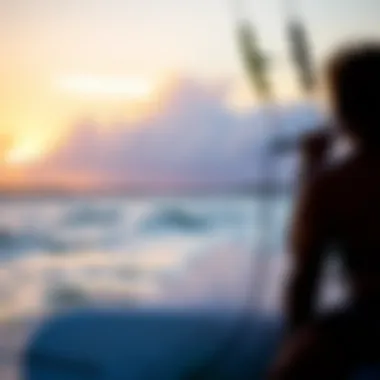
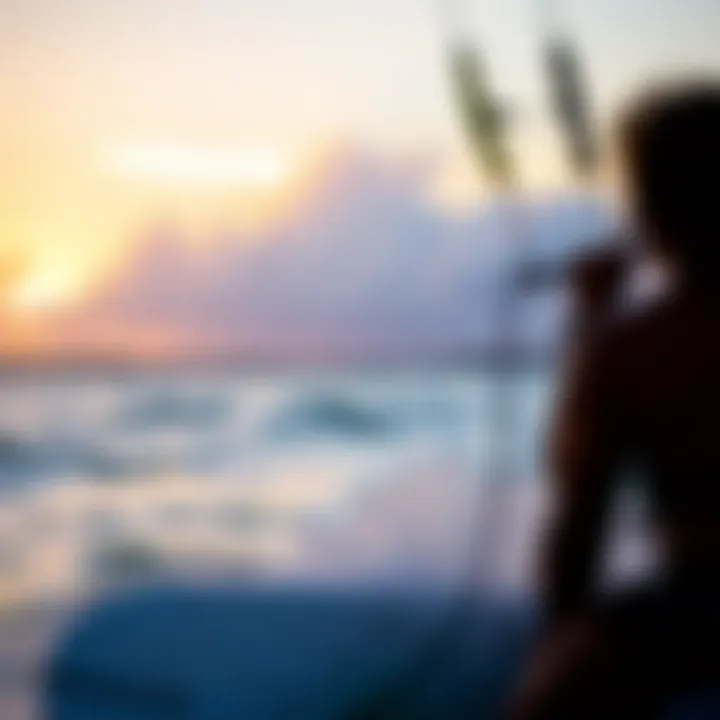
- YouTube: Plenty of content available, from tutorials to expert interviews.
- Kiteboarding Forums: Engaging with other kite surfers can expose you to local insights and often-hidden spots around Charleston.
- E-books: There are comprehensive guides available focusing on specific techniques, weather patterns, and safety tips.
Also, many websites have structured curricula or guides that can help set up a self-learning path for aspiring kite surfers. Keeping yourself updated through these resources is crucial, as kite surfing techniques and best practices continuously evolve.
Local Community and Networking Opportunities
One of the best aspects of learning to kite surf in Charleston is the rich community surrounding the sport. Local clubs and organizations offer a sense of belonging and numerous networking opportunities. Joining these groups can facilitate learning through shared experiences, and can act as a social guide through your kite surfing journey.
Here are some ways to integrate into the local kite surfing scene:
- Events and Meetups: Regular gatherings allow kite surfers to network, share tips, and inspire one another.
- Social Media Groups: Platforms like Facebook host groups where beginners can ask questions and receive advice.
- Local Competitions: Participating in (or even just watching) competitions gives newcomers insight into advanced techniques and kite handling.
In Charleston, connecting with others can enhance your kite surfing experience, turning a solo endeavor into a community-focused adventure.
"The beauty of kite surfing isn't just in riding; it's in the community that shares the wind and waves."
Engaging with fellow kite surfers provides not only knowledge but also a wealth of friendships that can last a lifetime. Whether you're just starting or looking to sharpen your skills, learning to kite surf in Charleston provides an exhilarating journey enriched by local culture and nature.
Popular Kite Surfing Spots in Charleston
Diving into the heart of kite surfing in Charleston means giving due attention to the spots that sparkle on this coastal jewel's landscape. These areas are not merely locations; they compose the very essence of the kite surfing experience. Each spot has its own flavor and vibe enhancing the pursuit of adrenaline and technical prowess.
Folly Beach, Isle of Palms, and Bohicket Creek stand out as premier destinations among kite surfers of all skill levels. What makes these locales special? Understanding their unique characteristics, challenges, and advantages can elevate your kiteboarding adventure. Whether you're an eager beginner or seasoned pro, knowing these spots inside and out can help you make the most of your time in the water.
Insight: Local knowledge can make a big difference when choosing a kite surfing spot. Each area has its preferences regarding wind conditions, tide patterns, and local regulations.
Folly Beach: A Kiteboarder's Paradise
Folly Beach has earned a rightful reputation as a kiteboarder’s paradise. The expansive flat waters and consistent wind patterns contribute to an ideal setup. You will find an eclectic mix of kite surfers, making it a social hub where shared experiences and friendships blossom.
The beach area of Folly is particularly favored because of its spaciousness. There's ample room to launch and land your kites safely. The locals here are generally welcoming, and you might often spot some highly-skilled riders executing jaw-dropping maneuvers. The vibe is laid-back, allowing for relaxed sessions even on busier days. With good access to amenities like eateries and restrooms, it’s a spot that combines thrill with comfort.
Isle of Palms: Ideal Conditions
If you're looking for reliably optimal conditions, look no further than Isle of Palms. This location often boasts steady winds and perfectly manageable waves, catering to both novice and expert kiteboarders. The downtown area buzzes with life, so after a hearty day on the water, you can unwind at local cafes and bars.
The shallow waters lure beginners, as they can practice their skills without the fear of deep water. However, experienced kite surfers won't feel left out, either. The small waves can be both playful and challenging, allowing for practicing jumps, tricks, and other advanced skills. Keep in mind to stay updated on the local wind forecasts as conditions can change, but when the timing is right, the thrill here is abundant.
Bohicket Creek: A Hidden Gem
Nestled away from the bustling beach spots, Bohicket Creek is a hidden gem for those in the know. While not as crowded as Folly Beach or Isle of Palms, it provides an equally enriching kite surfing experience. The creek’s conditions are often serene, exhibiting a combination of flat water and steady winds, which can be incredibly rewarding for various skill levels.
Because of its more secluded nature, riders here often experience a greater sense of solitude and connection with nature, a refreshing change from the popular hopping spots. Just be mindful of the tidal changes and any local wildlife; understanding the area serves as a bonus in improving your kiteboarding skills.
In summary, each kite surfing spot in Charleston brings its own unique aspects to the table. Whether it's the bustling crowds at Folly Beach, the reliable conditions at Isle of Palms, or the tranquil charm of Bohicket Creek, knowing what each location has to offer can greatly enhance your kite surfing adventure.
The Culture of Kite Surfing in Charleston
The culture of kite surfing in Charleston offers a vibrant tapestry woven from the threads of community, passion, and a shared love for the thrill of the ride. With the city's stunning coastal landscapes and diverse waterways providing the perfect backdrop, it becomes more than just a sport; it morphs into a way of life for many. In Charleston, kite surfing embodies a unique blend of adventure, artistry, and local camaraderie. The atmosphere is filled with both competition and cooperation, reflecting a community that celebrates achievements while fostering growth for all.
Local Events and Competitions
Throughout the year, Charleston plays host to a variety of kite surfing events that draw participants and spectators from around the region. These competitions not only showcase the athletic prowess of riders but also promote engagement among local kiteboarding enthusiasts. Events such as the Lowcountry Kite Fest and other local competitions allow both seasoned riders and newcomers to flaunt their skills while enjoying the spirited atmosphere.
"Kite surfing events create a bond among participants; they're often not just rivals but friends cheering each other on."
In addition to competitions, there are social gatherings organized by local kiteboarding groups, which serve as excellent opportunities for networking. For instance, the meet-ups at Folly Beach introduce newcomers to veterans, creating an inclusive environment where everyone's share of the stoke keeps rising. This camaraderie not only enhances the kite surfing experience but also strengthens the local kiteboarding community.
Environmental Initiatives and Preservation Efforts
Amidst the excitement of kite surfing, there lies a profound respect for the environment that sustains this sport. Local organizations and kite surfers are increasingly involved in environmental initiatives aimed at preserving Charleston's pristine coastlines and waterways. Clean-up campaigns are organized regularly to ensure that the beaches remain beautiful and the waters clean. The kite surfing community understands that a healthy environment is essential for sustained enjoyment of the sport.
Various programs also educate surfers about the importance of maintaining ecological balance. Workshops held by local groups focus on responsible riding and environmental stewardship, instilling a sense of responsibility among participants, especially the younger generations. This commitment to the environment not only fosters a culture of awareness but also aligns with broader conservation efforts in the area.
Spotlight on Local Kite Surfing Legends
Charleston boasts a host of local kite surfing legends who have significantly shaped the cultural landscape of the sport here. Figures such as Sammy Pottorff and Emily Skabelund have made indelible marks not only through their skills but also by passionately mentoring aspiring riders. Their influence extends beyond the water, as they actively participate in community-building initiatives that promote kite surfing as an accessible and welcoming sport.


The stories these legends share often reflect the spirit of kite surfing—embracing the challenges, celebrating victories, and encouraging others to find their own journey. They have become role models for many, instilling a sense of aspiration while fostering a culture of support and encouragement amongst all kite surfers in Charleston.
As you immerse yourself in kite surfing in Charleston, it’s easy to see how the sport acts as a catalyst for community bonding, environmental awareness, and mentorship, creating a rich cultural ethos that thrives amidst the stunning scenery.
Advanced Techniques and Training
In the world of kite surfing, advancing beyond basic skills is what separates die-hard enthusiasts from casual participants. Strong foundational skills are crucial, but understanding advanced techniques can unlock a new realm of possibilities on the water. This section dives into why honing your kite surfing capabilities is vital, along with practical tricks for intermediate riders and ways to immerse yourself in advanced clinics and workshops.
Tricks and Skills for Intermediate Riders
Once kitesurfers have mastered the fundamentals, it becomes essential to incorporate more complex maneuvers that leverage their existing skills. Intermediate riders often find themselves comfortable with basic jumps but may struggle when attempting to perform tricks, like the backloop or the kitesurfing-style flip.
These tricks not only enhance a rider's confidence but also significantly improve their overall kite control and board handling. Here’s a closer look at some popular tricks that every aspiring advanced rider should consider:
- Jumping Higher: Riders can practice loading the board up before taking off. This essentially involves bending your knees and using a pop technique to catch more air.
- Transitions: Seamless transitions from heel-side to toe-side can improve agility on the water. These can be practiced in flat conditions to perfect foot placements.
- Handle Passes: A handle pass maneuver is a more advanced trick that involves passing the bar from one hand to the other while airborne. It can be intricate, requiring good timing and awareness of wind conditions.
Mastering these tricks requires not just practice but also understanding specific body movements and kite positioning. Riders must remember that safety comes first. Always consider the wind conditions and potential obstacles nearby.
Participating in Advanced Clinics and Workshops
Engaging in professional clinics serves as a significant stepping stone for those looking to refine their skills. These clinics typically focus on advanced techniques and provide personalized coaching that helps wrestle with any bad habits that may have crept in during self-learning.
Most importantly, these gatherings often create a sense of community among participants. Here are several elements to keep in mind when considering advanced clinics:
- Curriculum: Look for programs that integrate both water-time and theoretical components, offering insights into both the mechanics of tricks and their execution.
- Instructor Expertise: Choose clinics hosted by recognized kite surfing instructors who bring years of experience and knowledge.
- Peer Interaction: The opportunity to meet fellow enthusiasts can lead to sharing valuable tips or even potential future training buddies.
- Location: The ideal venue enhances skills training. Charleston's myriad waterways offer diverse challenges, from flatwater practice to wave strategy.
Additionally, consider reaching out to local kiteboarding schools or forums on platforms like Reddit (reddit.com/r/Kitesurfing/) to find information on upcoming clinics or workshops focused on advanced kite surfing skills.
"The waters of Charleston aren’t just for play—they're a vast training ground for both spirit and skill."
Ultimately, pushing the envelope in kite surfing is all about continual learning and practice. It isn’t merely a sport but an art that requires time, effort, and the right guidance. Whether it's refining tricks or participating in focused clinics, advancing your skills will only enhance the joy and excitement of kite surfing.
Challenges and Considerations in Kite Surfing
Kite surfing presents a unique blend of thrill and technique, but it doesn't come without its challenges. As with any sport that harnesses the forces of nature, understanding these challenges is crucial for both safety and enjoyment. Knowing what to look out for can make all the difference between an exhilarating ride or a precarious situation. Here, we will explore some key elements and considerations that both beginners and seasoned kiteboarders should keep in mind when hitting the waters.
Understanding Weather Risks
Weather patterns can be as unpredictable as a cat on a hot tin roof. A sunny day can quickly turn into blustery conditions that are less than ideal for kite surfing. Wind speed and direction are perhaps the most critical factors in kite surfing. Ideal winds for the sport generally range from 12 to 25 knots. However, anything above 25 knots can escalate quickly, leading to dangerous conditions for riders, especially those still learning the ropes.
Key Points to Consider:
- Wind Conditions: Always check forecasts before you go out. Wind can change in a heartbeat, and being caught off guard can lead to accidents or worse.
- Storm Warnings: Keep an eye out for weather alerts. Storms can produce winds that whip up the water while also bringing lightning, which is a recipe for disaster.
- Local Microclimates: Charleston's coastal geography means that weather can vary widely even within short distances. Winds that seem calm in one area may be strong at another spot close by.
A more seasoned rider might examine forecasts from sources like WindFinder or Weather Underground, which offer localized data crucial for planning sessions.
"Knowing your environment is half the battle. Success on the water is as much about understanding the conditions as it is about skill."
Navigating Regulations and Local Laws
Another aspect worth considering is the intricate web of regulations surrounding kite surfing. Various laws govern where, when, and how kite surfing can be practiced. Familiarity with these regulations not only keeps you in good standing with local authorities, but also contributes to the overall safety of the community.
Important Regulations to Note:
- Restricted Areas: Certain beaches or parks may have designated no-kite zones. Always check with local bodies like the Charleston Parks and Recreation Department or the South Carolina Department of Natural Resources to find updated regulations.
- Licensing and Permits: In some locations, a permit may be required to kite surf, especially in crowded areas. It’s prudent to ensure that you’ve dotted all your i’s and crossed your t’s.
- Liability Waivers: Some schools or rental centers may ask you to sign a liability waiver before you hit the water, requiring you to acknowledge the risks involved.
Keeping abreast of regulations not only helps you avoid potential fines but also fosters a safer environment for everyone involved. Being a responsible kiter sends a message to both the community and the environment, ensuring that future generations can enjoy the thrill of kite surfing in Charleston just as we do today.
Finale
Kite surfing in Charleston is not just a sport; it’s a vibrant community where the thrill of the ocean meets the winds of adventure. This article has journeyed through the essential aspects of kite surfing, covering everything from local conditions to advanced techniques.
Embracing the Kite Surfing Experience in Charleston
Kite surfing is an exhilarating way to connect with the elements while also encouraging personal growth and physical fitness. Embracing the kite surfing experience in Charleston means immersing oneself fully into its unique culture and environment. The city offers more than just great spots to ride; it’s about the camaraderie among kite surfers who share a passion for harnessing the wind.
For those looking to dive into this world, here are a few important elements to consider that stand out:
- Community Support: Engaging with local kiteboarding schools and clubs can greatly enhance your learning experience. These communities not only provide instruction but also foster friendships that enrich your time on the water.
- Consistency of Conditions: Charleston's weather is generally favorable, with steady winds that make kite surfing accessible for most of the year. Knowing when and where to surf can help you avoid crowded spots while also ensuring a safe experience.
- Environmental Awareness: Kite surfers in Charleston are often at the forefront of environmental initiatives, understanding that the health of local waters directly influences their sport. Participating in beach clean-ups or conservation efforts can deepen your connection to the sport and its surroundings.
"The beauty of kite surfing in Charleston lies not just in the riding but also in the connections we make and the environment we cherish."
With eyes on the horizon and the wind at your back, there’s a world waiting to be explored. To truly embrace kite surfing in Charleston, it’s about balancing skill with respect for the elements. Whether you’re a novice or an experienced rider, this coastal gem offers an ever-evolving playground that beckons for discovery.
As you pack your gear and plan your next outing, remember that kite surfing is a journey—a blend of challenge, joy, and connection to nature. Embrace it wholeheartedly.







